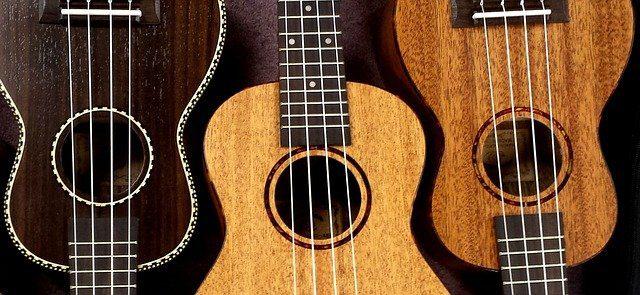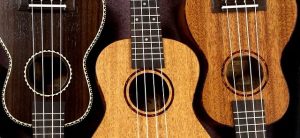When you enter the market to buy yourself a new (or used) ukulele there are many factors to take into account: size of the uke, the type of woods used, the level of craftsmanship, and most importantly the price you’ll pay to get your hands on it. In doing your research, the most important thing to start off with is your price cap.
Are you looking for the cheapest uke you can find, which would be anywhere from $20-40? Is it the next level up, around $100-200? Or is it the tier where the instruments really start to get select types of wood, master level attention to detail, and quality control directly from the luthier shop? This tier sets our ukes at around $500-1000 and this is where we start to see some repeat company names in our search results.
Kamaka & Martin Ukuleles are Two Standouts in the Higher Price Range
Two standouts in this price range are the Hawaiin based Kamaka and the staple of acoustic instruments in America, Martin. Here I will give you a pathway to analyze Kamaka vs Martin Ukuleles and find out which would be best for you and your ukulele playing.
I want to stress that neither option is correct or better, they will have their own sets of pros and cons. I also want to stress that each individual instrument is unique, so even two ukuleles made by the same company with the same specs may sound completely different in your hands, so the best option is always to play these instruments before making the decision to buy. But with that being said, you can still get within a ballpark of a sound you are looking for knowing a few things about how Ukes are made. Before we dive into that, let’s discuss the backgrounds behind our two companies under the microscope.
Kamaka
Kamaka was established in Kaimuki, Hawaii in the year 1916. They quickly garnered a reputation for making high quality ukuleles across the world, and in the 1920’s the founder Samual Kamaka designed a “pineapple” shaped body style that gave the instrument a much more resonant and mellow tone as compared to the standard “figure eight” style body shapes which came from the classical guitar. This company is still owned and operated by descendants of Samual Kamaka and still produces only the highest quality instruments.
Martin
C.F. Martin & Co. is true acoustic instrument royalty. Established in 1833, this company’s guitars have been at the forefront of modern music for close to 200 years. Their founder C. F. Martin was the first luthier to use what is called “X-Braces” on the underside of the top of a guitar, which has now become a given in the acoustic instrument marketplace due to its ability to create a richer tone in the instruments. In 1915 C. F. Martin’s grandson F. H. Martin started tinkering with Martin’s first line of ukuleles entering the market in 1917.
Tonewoods
One of the largest factors in how a uke will sound comes down to what kind of wood is used to build it. Typically the wood is separated into two categories depending on where it is found on the instrument: the “top” and the “back and sides”. Sometimes these woods will be the same, but frequently they will be different.
The woods on the top will usually be a “brighter” sounding wood to help with the transmission of the sound out of the sound hole. Three common woods that are used on ukuleles are Spruce, Koa, and Mahogany. Think of those as “brightest”, “balanced”, and “mellow and rich”, respectively. While both companies make both types of ukuleles, it is easier to find Martin ukuleles using Mahogany, and Kamaka using Koa.
Craftsmanship
Both of these companies have a very respected level of craftsmanship, but it is worth discussing the differences between them. Kamaka is a smaller operation, thus all of their instruments are getting high attention to detail from start to finish. Martin is a large company who makes many types of instruments and accessories, so depending on which factory your ukulele was built in will have an effect on its quality. Their instruments still have humans building them, but many parts of the process are automated and thus the quality will suffer slightly. This will also be reflected in the price: since Martin has a high level of distribution and ability to produce tons of instruments, they are able to sell their instruments for cheaper without suffering a huge downgrade in quality.
Availability
One other big factor to consider in the Kamaka vs Martin ukulele debate is your ability to find these instruments both online and in person. Again, due to Martin’s large network of production and distribution they are able to supply the market with more of their ukuleles, so they are relatively easy to find with a quick search or visit to your local music store. But Kamakas are almost the opposite: because of their small size they are a more niche purchase, thus most shops don’t supply them or there are simply not enough made every year to keep them in stock (because they’re that sought after). So if the ease of finding one, trying it out, and being able to purchase it is most important you’ll need to factor in these variables.
So in short, there again is no right or wrong way to go about purchasing a ukulele of this size. There are no losers in the Kamaka vs Martin ukuleles debate. The largest things to look out for are their tonewoods, size of the instrument, and availability. But as far as quality they both have a unique take on the market: Martin is a large but extremely well established company with many systems in place to guarantee quality out of the factory, where Kamaka is a relatively smaller company with a stronger human attention to detail and thus a much harder to find but more sought after instrument. Happy searching!
Grant Hudson

